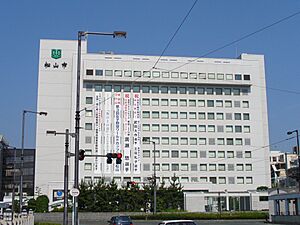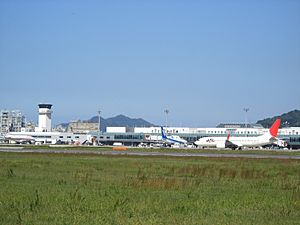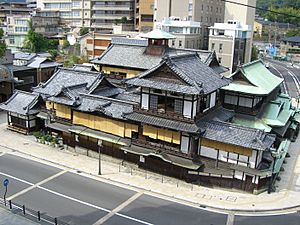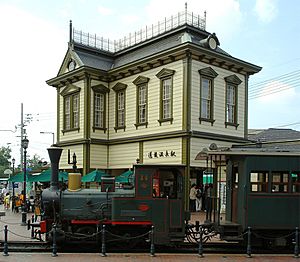Matsuyama facts for kids
Quick facts for kids
Matsuyama
松山市
|
|||||||||
|---|---|---|---|---|---|---|---|---|---|

From top left:Dōgo Onsen Honkan, Stone monument of Shiki Masaoka, Matsuyama Castle, Botchan train, The gate of Ishite-ji, Iyotetsu Matsuyama-shi Station, Gintengai Street
|
|||||||||
|
|||||||||
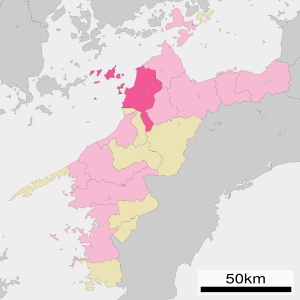 |
|||||||||
| Country | Japan | ||||||||
| Region | Shikoku | ||||||||
| Prefecture | Ehime | ||||||||
| Area | |||||||||
| • Total | 429.35 km2 (165.77 sq mi) | ||||||||
| Population
(October 1, 2022)
|
|||||||||
| • Total | 505,948 | ||||||||
| • Density | 1,178.405/km2 (3,052.05/sq mi) | ||||||||
| Time zone | UTC+09:00 (JST) | ||||||||
| City hall address | 4-7-2 Nibanchō, Matsuyama-shi, Ehime-ken 790-8571 | ||||||||
|
|||||||||
Matsuyama (松山市, Matsuyama-shi) is the main city of Ehime Prefecture. It is located on the island of Shikoku, in Japan. Matsuyama is also the largest city on Shikoku island. As of October 1, 2022, about 505,948 people live there. The city covers an area of 429.35 square kilometers (165.77 sq mi).
Contents
Exploring Matsuyama's Location
Matsuyama is in the middle of Ehime Prefecture. It faces the Seto Inland Sea to the north. Mountains surround it to the north, east, and south. The city also includes 29 islands in the Seto Inland Sea, called the Kutsuna Islands.
Nearby Towns and Cities
Matsuyama is close to several other places in Ehime Prefecture:
- Imabari
- Kumakōgen
- Masaki
- Tobe
- Tōon
Matsuyama's Weather
Matsuyama has a humid subtropical climate. This means it has hot summers and cool winters. It rains a lot throughout the year, especially from April to July and again in September.
People of Matsuyama
The number of people living in Matsuyama grew steadily during the 1900s. In the 2000s, the population has stayed about the same or slightly decreased.
A Look at Matsuyama's Past
The area where Matsuyama is now was once part of an old province called Iyo. Dōgo Onsen, a famous hot spring, was well-known even in the year 596. A famous prince named Shōtoku Taishi visited it then.
Later, a powerful family called the Kōno clan built their main fort near Dōgo Onsen. They also developed a port called Mitsuhama. This port helped connect the area to other big islands of Japan.
In the 1600s, Matsuyama Castle was built. A castle town grew up around it. This town became the center of the modern city we know today. Matsuyama officially became a city on December 15, 1889.
During World War II, on July 26, 1945, Matsuyama was bombed. More than half of the city was destroyed. After the war, Matsuyama grew by joining with nearby towns like Dōgo and Mitsuhama. This helped it become the largest city in Shikoku.
Matsuyama's Economy
Matsuyama is an important business center for its region. Its main industries include:
- Agriculture: Especially growing mandarin oranges.
- Tourism: People visit for the Dōgo Onsen hot springs and Matsuyama Castle.
- Manufacturing: Factories here make things like chemical fibers, boilers, and tractors.
Many companies, including those making Japanese sweets and drinks, have their main offices in Matsuyama.
Learning in Matsuyama
Matsuyama has many schools and universities.
Universities and Colleges
- Ehime University
- Matsuyama Junior College
- Matsuyama Shinonome College
- Matsuyama University
- St. Catherine University
Schools for Kids
The city government runs 62 public elementary schools and 31 public middle schools. There are also seven public high schools run by the Ehime Prefecture. Ehime University runs two national high schools. Matsuyama also has private schools and special education schools.
International Schools
There is one Korean school in Matsuyama, called the Shikoku Korean Elementary and Junior High School.
Getting Around Matsuyama
Matsuyama has an airport, train lines, and a tram system.
Air Travel
Train Travel
Matsuyama has train services run by two companies:
Shikoku Railway Company - Yosan Line
- Asanami
- Ōura
- Iyo-Hōjō
- Yanagihara
- Awai
- Kōyōdai
- Horie
- Iyo-Wake
- Mitsuhama
- Matsuyama
- Ichitsubo
Iyotetsu - Takahama Line
- Takahama
- Baishinji
- Minatoyama
- Mitsu
- Yamanishi
- Nishi-Kinuyama
- Kinuyama
- Komachi
- Ōtemachi
- Matsuyama City
Iyotetsu - Yokogawara Line
- Matsuyama City
- Ishitegawa Park
- Iyo-Tachibana
- Fukuonji
- Kita-Kume
- Kume
- Takanoko
- Hirai
- Umenomoto
Iyotetsu - Gunchū Line
- Matsuyama City
- Dobashi
- Doida
- Yōgo
- Kamata
Trams and Buses
The Iyo Railway also runs trams and buses. These are the main ways people get around the city. Matsuyama is special because it has kept its original tram system running since 1887!
Highways
Major roads connect Matsuyama to other parts of Japan. These include:
 Matsuyama Expressway
Matsuyama Expressway- Route 11
- Route 33
- Route 56
- Route 196
- Route 317
- Route 379
- Route 437
Ports and Ferries
- Port of Matsuyama: From here, you can take ferries to Hiroshima, Kobe, and other cities. There's also a fast hydrofoil service to Hiroshima.
Friendship Around the World
Matsuyama has special connections with cities in other countries. These are called "sister cities" or "friendship cities."
 Freiburg, Germany
Freiburg, Germany Pyeongtaek, South Korea
Pyeongtaek, South Korea Sacramento, United States
Sacramento, United States Taipei, Taiwan (friendship city)
Taipei, Taiwan (friendship city)
Fun Places to Visit in Matsuyama
Matsuyama is famous for its hot springs, called onsen. One of the oldest and most famous is the Dōgo Onsen Honkan. It's a beautiful wooden bathhouse built in 1894. Another popular place is Matsuyama Castle.
Matsuyama is also home to eight of the 88 temples on the famous Shikoku Pilgrimage. Some of these temples, like Ishite-ji, Taisan-ji, and Jōdo-ji, are very old, dating back to the 700s.
Poetry and Literature
The city is a big center for haiku poetry. A famous haiku poet named Masaoka Shiki lived here. You can visit his old house, called the Shiki-do, and a museum about him. Matsuyama even gives out international awards for haiku poetry!
The famous Japanese novel Botchan by Natsume Sōseki is set in Matsuyama. Because of this book, you'll find many things named after the main character, Botchan. For example, there's Botchan Stadium and the Botchan Ressha, an old-fashioned train that runs on the city's tram lines. You can also try "Botchan dango" sweets!
Matsuyama is also featured in the popular novel Saka no Ue no Kumo (Clouds Above the Hill). There's a museum dedicated to this book and its TV show.
Museums to Explore
Matsuyama has several interesting museums:
- The Museum of Art, Ehime: This museum shows art by local artists.
- Shiki Memorial Museum: Learn all about the life and works of poet Masaoka Shiki.
- Saka no Ue no Kumo Museum: Explore exhibits related to the famous novel and TV series.
- Juzo Itami museum: Dedicated to the film director Juzo Itami.
Local Treats and Festivals
When you visit Matsuyama, be sure to try some local treats!
- Tarts: These are a type of cake that came from Portugal. The lord of Matsuyama Castle changed the recipe by adding red bean paste. Now, there are many kinds, some with yuzu fruit or chestnuts.
- Botchan dango: Named after the novel Botchan, these are three colorful sweet rice balls (mochi) with different flavors: green tea, egg, and red bean paste.
Matsuyama also has many exciting festivals throughout the year, including the Dogo Festival in spring, the Matsuyama Festival in August, and the Fall Festival in October, which features battling mikoshi (portable shrines).
Sports Teams
Matsuyama has its own sports teams:
- Ehime FC: This is the city's professional soccer team, which plays in the J. League.
- Ehime Mandarin Pirates: This baseball team plays in the Shikoku Island League Plus.
Famous People from Matsuyama
Many notable people were born or lived in Matsuyama:
- Kenta Abe, baseball player
- Akiyama Saneyuki, a famous admiral
- Akiyama Yoshifuru, a famous general
- Kotomi Aoki, manga artist
- Ryō Aono, snowboarder
- Harada Sanosuke, a samurai
- Ippen, a Buddhist teacher
- Juzo Itami, film director
- Masaoka Shiki, a famous haiku poet
- Hideki Matsuyama, golfer
- Kenzaburō Ōe, a Nobel Prize-winning writer
- Kyoshi Takahama, poet
- Taneda Santōka, haiku poet
See also
 In Spanish: Matsuyama para niños
In Spanish: Matsuyama para niños





